艾丽斯·沃克作品《Everyday Use》赏析
- 格式:ppt
- 大小:398.00 KB
- 文档页数:6
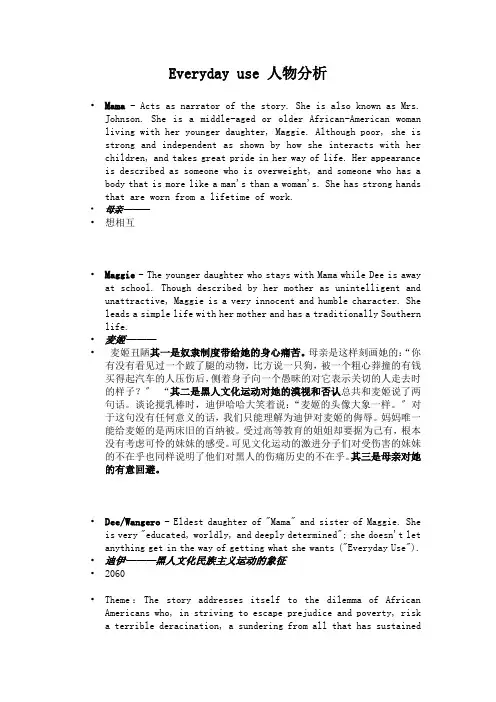
Everyday use 人物分析•Mama -Acts as narrator of the story. She is also known as Mrs.Johnson. She is a middle-aged or older African-American woman living with her younger daughter, Maggie. Although poor, she is strong and independent as shown by how she interacts with her children, and takes great pride in her way of life. Her appearance is described as someone who is overweight, and someone who has a body that is more like a man's than a woman's. She has strong hands that are worn from a lifetime of work.•母亲———•想相互•Maggie-The younger daughter who stays with Mama while Dee is away at school. Though described by her mother as unintelligent and unattractive, Maggie is a very innocent and humble character. She leads a simple life with her mother and has a traditionally Southern life.•麦姬———•麦姬丑陋其一是奴隶制度带给她的身心痛苦。
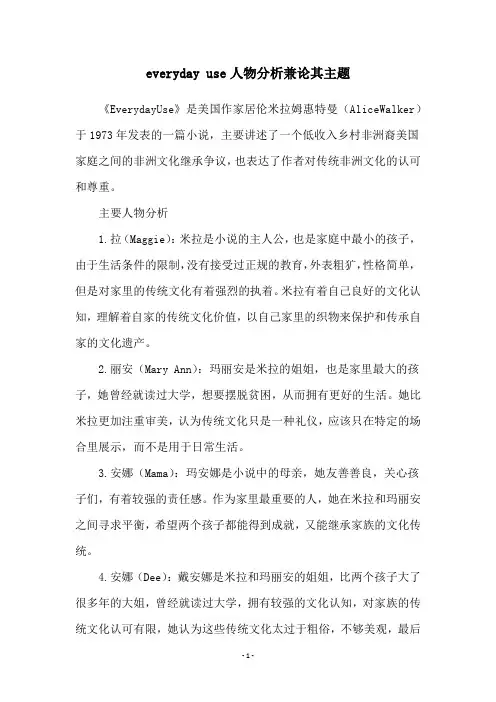
everyday use人物分析兼论其主题《EverydayUse》是美国作家居伦米拉姆惠特曼(AliceWalker)于1973年发表的一篇小说,主要讲述了一个低收入乡村非洲裔美国家庭之间的非洲文化继承争议,也表达了作者对传统非洲文化的认可和尊重。
主要人物分析1.拉(Maggie):米拉是小说的主人公,也是家庭中最小的孩子,由于生活条件的限制,没有接受过正规的教育,外表粗犷,性格简单,但是对家里的传统文化有着强烈的执着。
米拉有着自己良好的文化认知,理解着自家的传统文化价值,以自己家里的织物来保护和传承自家的文化遗产。
2.丽安(Mary Ann):玛丽安是米拉的姐姐,也是家里最大的孩子,她曾经就读过大学,想要摆脱贫困,从而拥有更好的生活。
她比米拉更加注重审美,认为传统文化只是一种礼仪,应该只在特定的场合里展示,而不是用于日常生活。
3.安娜(Mama):玛安娜是小说中的母亲,她友善善良,关心孩子们,有着较强的责任感。
作为家里最重要的人,她在米拉和玛丽安之间寻求平衡,希望两个孩子都能得到成就,又能继承家族的文化传统。
4.安娜(Dee):戴安娜是米拉和玛丽安的姐姐,比两个孩子大了很多年的大姐,曾经就读过大学,拥有较强的文化认知,对家族的传统文化认可有限,她认为这些传统文化太过于粗俗,不够美观,最后把它们拿来当做收藏品展示在家里。
人物特征看,米拉在家庭有著最深厚的文化认知,追求著文化的承和煌;而玛丽安家族文化有度反感,希望能摆脱贫困,过上更好的生活。
玛安娜在米拉和玛丽安之,她既知道家族文化的重要性,也理解玛丽安改善生活的追求,於双方的力求公平,人都能得到尊重。
戴安娜於家族的传统文化有限的认可,而她想要把它们拿当做收藏品展示在家里,展示自家文化的象征性,也是於家族文化的致敬。
最,《Everyday Use》的主题是“文化继承”。
作者用家族中三名不同文化认知水平的主要人物来表现这个主题,讲述了家庭中个孩子在文化继承上的分歧。
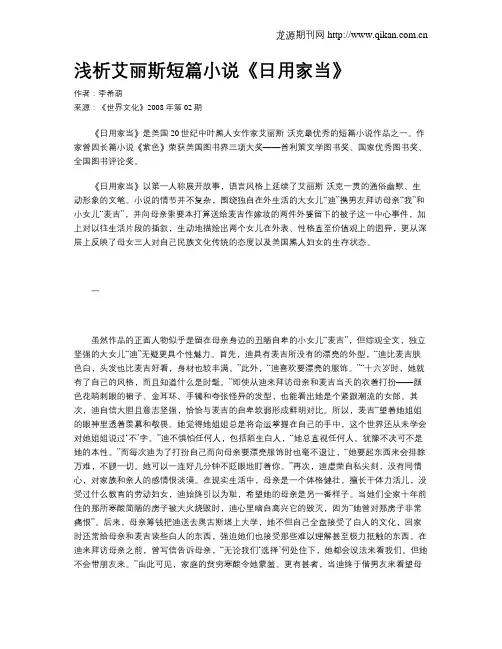
浅析艾丽斯短篇小说《日用家当》作者:李希萌来源:《世界文化》2008年第02期《日用家当》是美国20世纪中叶黑人女作家艾丽斯·沃克最优秀的短篇小说作品之一。
作家曾因长篇小说《紫色》荣获美国图书界三项大奖——普利策文学图书奖、国家优秀图书奖、全国图书评论奖。
《日用家当》以第一人称展开故事,语言风格上延续了艾丽斯·沃克一贯的通俗幽默、生动形象的文笔。
小说的情节并不复杂,围绕独自在外生活的大女儿“迪”携男友拜访母亲“我”和小女儿“麦吉”,并向母亲索要本打算送给麦吉作嫁妆的两件外婆留下的被子这一中心事件,加上对以往生活片段的插叙,生动地描绘出两个女儿在外表、性格直至价值观上的迥异,更从深层上反映了母女三人对自己民族文化传统的态度以及美国黑人妇女的生存状态。
一虽然作品的正面人物似乎是留在母亲身边的丑陋自卑的小女儿“麦吉”,但综观全文,独立坚强的大女儿“迪”无疑更具个性魅力。
首先,迪具有麦吉所没有的漂亮的外型,“迪比麦吉肤色白,头发也比麦吉好看,身材也较丰满。
”此外,“迪喜欢要漂亮的服饰。
”“十六岁时,她就有了自己的风格,而且知道什么是时髦。
”即使从迪来拜访母亲和麦吉当天的衣着打扮——颜色花哨刺眼的裙子、金耳环、手镯和夸张怪异的发型,也能看出她是个紧跟潮流的女郎。
其次,迪自信大胆且意志坚强,恰恰与麦吉的自卑软弱形成鲜明对比。
所以,麦吉“望着她姐姐的眼神里透着羡慕和敬畏。
她觉得她姐姐总是将命运掌握在自己的手中,这个世界还从未学会对她姐姐说过‘不’字。
”迪不惧怕任何人,包括陌生白人,“她总直视任何人。
犹豫不决可不是她的本性。
”而每次迪为了打扮自己而向母亲要漂亮服饰时也毫不退让,“她要起东西来会排除万难,不顾一切。
她可以一连好几分钟不眨眼地盯着你。
”再次,迪虚荣自私尖刻,没有同情心,对家族和亲人的感情很淡漠。
在现实生活中,母亲是一个体格健壮,擅长干体力活儿,没受过什么教育的劳动妇女,迪始终引以为耻,希望她的母亲是另一番样子。
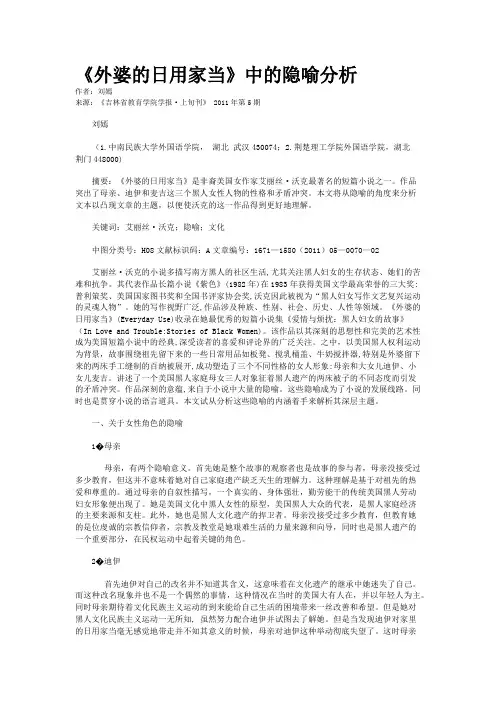
《外婆的日用家当》中的隐喻分析作者:刘嫣来源:《吉林省教育学院学报·上旬刊》 2011年第5期刘嫣(1.中南民族大学外国语学院,湖北武汉430074;2.荆楚理工学院外国语学院,湖北荆门448000)摘要:《外婆的日用家当》是非裔美国女作家艾丽丝·沃克最著名的短篇小说之一。
作品突出了母亲、迪伊和麦吉这三个黑人女性人物的性格和矛盾冲突。
本文将从隐喻的角度来分析文本以凸现文章的主题,以便使沃克的这一作品得到更好地理解。
关键词:艾丽丝·沃克;隐喻;文化中图分类号:H08文献标识码:A文章编号:1671—1580(2011)05—0070—02艾丽丝·沃克的小说多描写南方黑人的社区生活,尤其关注黑人妇女的生存状态、她们的苦难和抗争。
其代表作品长篇小说《紫色》(1982年)在1983年获得美国文学最高荣誉的三大奖:普利策奖、美国国家图书奖和全国书评家协会奖,沃克因此被视为“黑人妇女写作文艺复兴运动的灵魂人物”。
她的写作视野广泛,作品涉及种族、性别、社会、历史、人性等领域。
《外婆的日用家当》(Everyday Use)收录在她最优秀的短篇小说集《爱情与烦扰:黑人妇女的故事》(In Love and Trouble:Stories of Black Women)。
该作品以其深刻的思想性和完美的艺术性成为美国短篇小说中的经典,深受读者的喜爱和评论界的广泛关注。
之中,以美国黑人权利运动为背景,故事围绕祖先留下来的一些日常用品如板凳、搅乳桶盖、牛奶搅拌器,特别是外婆留下来的两床手工缝制的百纳被展开,成功塑造了三个不同性格的女人形象:母亲和大女儿迪伊、小女儿麦吉。
讲述了一个美国黑人家庭母女三人对象征着黑人遗产的两床被子的不同态度而引发的矛盾冲突。
作品深刻的意蕴,来自于小说中大量的隐喻。
这些隐喻成为了小说的发展线路。
同时也是贯穿小说的语言道具。
本文试从分析这些隐喻的内涵着手来解析其深层主题。
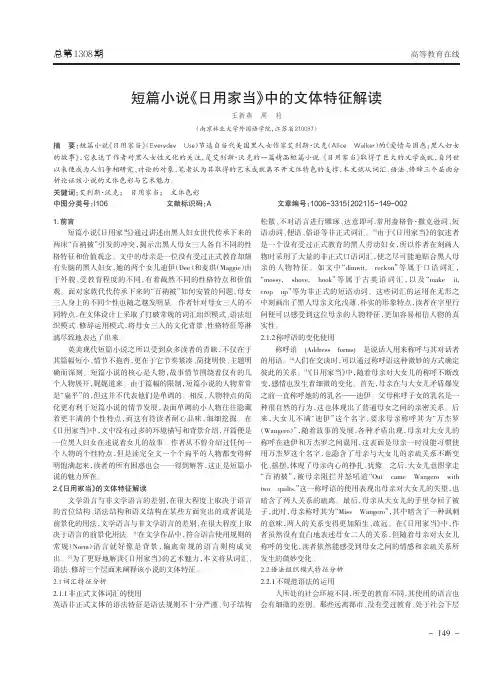
1.前言短篇小说《日用家当》通过讲述由黑人妇女世代传承下来的两床“百衲被”引发的冲突,揭示出黑人母女三人各自不同的性格特征和价值观念。
文中的母亲是一位没有受过正式教育却颇有头脑的黑人妇女,她的两个女儿迪伊(Dee )和麦琪(Maggie )由于外貌、受教育程度的不同,有着截然不同的性格特点和价值观。
面对家族代代传承下来的“百衲被”如何安置的问题,母女三人身上的不同个性也随之越发明显。
作者针对母女三人的不同特点,在文体设计上采取了打破常规的词汇组织模式、语法组织模式、修辞运用模式,将母女三人的文化背景、性格特征等淋漓尽致地表达了出来。
英美现代短篇小说之所以受到众多读者的青睐,不仅在于其篇幅短小、情节不拖沓,更在于它节奏紧凑、简捷明快、主题明确而深刻。
短篇小说的核心是人物,故事情节围绕着仅有的几个人物展开,娓娓道来。
由于篇幅的限制,短篇小说的人物常常是“扁平”的,但这并不代表他们是单调的。
相反,人物特点的简化更有利于短篇小说的情节发展,表面单调的小人物往往隐藏着更丰满的个性特点,而这有待读者耐心品味,细细挖掘。
在《日用家当》中,文中没有过多的环境描写和背景介绍,开篇便是一位黑人妇女在述说着女儿的故事。
作者从不曾介绍过任何一个人物的个性特点,但是读完全文一个个扁平的人物都变得鲜明饱满起来,读者的所有困惑也会一一得到解答,这正是短篇小说的魅力所在。
2.《日用家当》的文体特征解读文学语言与非文学语言的差别,在很大程度上取决于语言的音位结构、语法结构和语义结构在某些方面突出的或者说是前景化的用法,文学语言与非文学语言的差别,在很大程度上取决于语言的前景化用法。
[1]在文学作品中,符合语言使用规则的常规(Norm )语言就好像是背景,偏离常规的语言则构成突出。
[2]为了更好地解读《日用家当》的艺术魅力,本文将从词汇、语法、修辞三个层面来阐释该小说的文体特征。
2.1词汇特征分析2.1.1非正式文体词汇的使用英语非正式文体的语法特征是语法规则不十分严谨、句子结构松散、不对语言进行雕琢、达意即可,常用盎格鲁·撒克逊词、短语动词、俚语、俗语等非正式词汇。
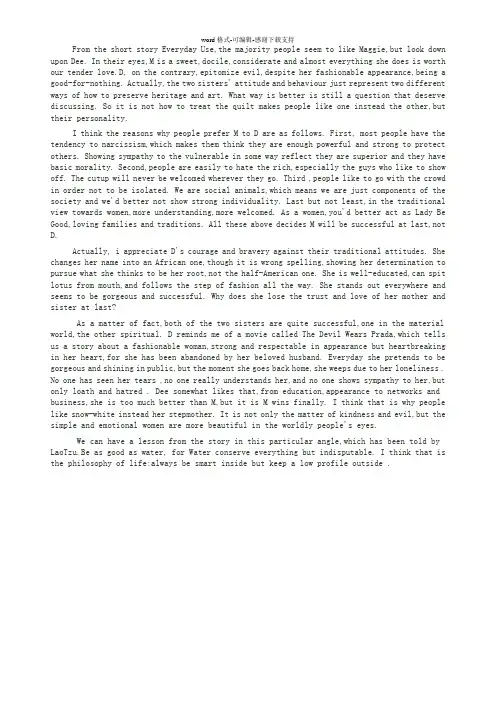
word格式-可编辑-感谢下载支持From the short story Everyday Use,the majority people seem to like Maggie,but look down upon Dee. In their eyes,M is a sweet,docile,considerate and almost everything she does is worth our tender love.D, on the contrary,epitomize evil,despite her fashionable appearance,being a good-for-nothing. Actually,the two sisters' attitude and behaviour just represent two different ways of how to preserve heritage and art. What way is better is still a question that deserve discussing. So it is not how to treat the quilt makes people like one instead the other,but their personality.I think the reasons why people prefer M to D are as follows. First, most people have the tendency to narcissism,which makes them think they are enough powerful and strong to protect others. Showing sympathy to the vulnerable in some way reflect they are superior and they have basic morality. Second,people are easily to hate the rich,especially the guys who like to show off. The cutup will never be welcomed wherever they go. Third ,people like to go with the crowd in order not to be isolated. We are social animals,which means we are just components of the society and we'd better not show strong individuality. Last but not least,in the traditional view towards women,more understanding,more welcomed. As a women,you'd better act as Lady Be Good,loving families and traditions. All these above decides M will be successful at last,not D.Actually, i appreciate D's courage and bravery against their traditional attitudes. She changes her name into an African one,though it is wrong spelling,showing her determination to pursue what she thinks to be her root,not the half-American one. She is well-educated,can spit lotus from mouth,and follows the step of fashion all the way. She stands out everywhere and seems to be gorgeous and successful. Why does she lose the trust and love of her mother and sister at last?As a matter of fact,both of the two sisters are quite successful,one in the material world,the other spiritual. D reminds me of a movie called The Devil Wears Prada,which tells us a story about a fashionable woman,strong and respectable in appearance but heartbreaking in her heart,for she has been abandoned by her beloved husband. Everyday she pretends to be gorgeous and shining in public,but the moment she goes back home,she weeps due to her loneliness . No one has seen her tears ,no one really understands her,and no one shows sympathy to her,but only loath and hatred . Dee somewhat likes that,from education,appearance to networks and business,she is too much better than M,but it is M wins finally. I think that is why people like snow-white instead her stepmother. It is not only the matter of kindness and evil,but the simple and emotional women are more beautiful in the worldly people's eyes.We can have a lesson from the story in this particular angle,which has been told by LaoTzu.Be as good as water, for Water conserve everything but indisputable. I think that is the philosophy of life:always be smart inside but keep a low profile outside .。
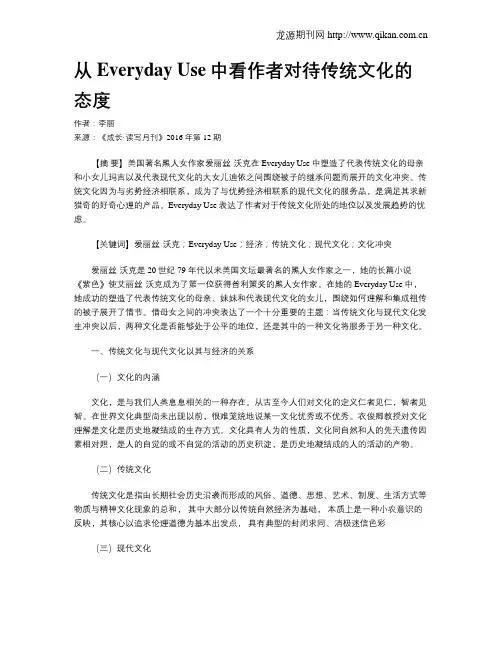
从Everyday Use中看作者对待传统文化的态度作者:李丽来源:《成长·读写月刊》2016年第12期【摘要】美国著名黑人女作家爱丽丝·沃克在Everyday Use中塑造了代表传统文化的母亲和小女儿玛吉以及代表现代文化的大女儿迪依之间围绕被子的继承问题而展开的文化冲突。
传统文化因为与劣势经济相联系,成为了与优势经济相联系的现代文化的服务品,是满足其求新猎奇的好奇心理的产品。
Everyday Use表达了作者对于传统文化所处的地位以及发展趋势的忧虑。
【关键词】爱丽丝·沃克;Everyday Use;经济;传统文化;现代文化;文化冲突爱丽丝·沃克是20世纪79年代以来美国文坛最著名的黑人女作家之一,她的长篇小说《紫色》使艾丽丝·沃克成为了第一位获得普利策奖的黑人女作家。
在她的Everyday Use中,她成功的塑造了代表传统文化的母亲、妹妹和代表现代文化的女儿,围绕如何理解和集成祖传的被子展开了情节。
借母女之间的冲突表达了一个十分重要的主题:当传统文化与现代文化发生冲突以后,两种文化是否能够处于公平的地位,还是其中的一种文化将服务于另一种文化。
一、传统文化与现代文化以其与经济的关系(一)文化的内涵文化,是与我们人类息息相关的一种存在。
从古至今人们对文化的定义仁者见仁,智者见智。
在世界文化典型尚未出现以前,很难笼统地说某一文化优秀或不优秀。
衣俊卿教授对文化理解是文化是历史地凝结成的生存方式。
文化具有人为的性质,文化同自然和人的先天遗传因素相对照,是人的自觉的或不自觉的活动的历史积淀,是历史地凝结成的人的活动的产物。
(二)传统文化传统文化是指由长期社会历史沿袭而形成的风俗、道德、思想、艺术、制度、生活方式等物质与精神文化现象的总和,其中大部分以传统自然经济为基础,本质上是一种小农意识的反映,其核心以追求伦理道德为基本出发点,具有典型的封闭求同、消极迷信色彩(三)现代文化现代文化主要指由传统社会向经济富裕、政治稳定、科技发达的现代社会过渡中形成的文化。

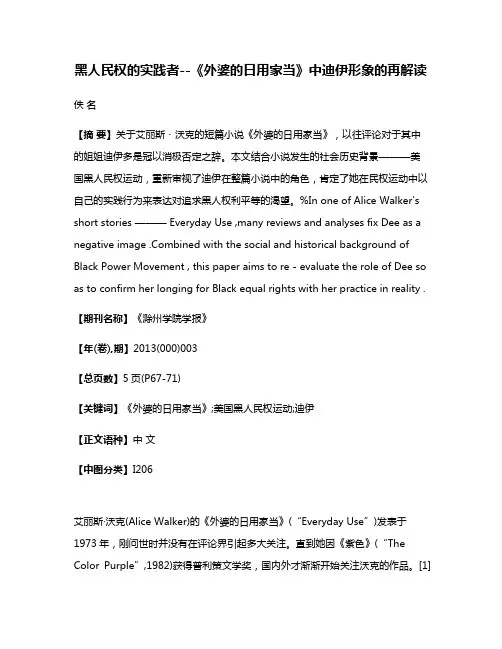
黑人民权的实践者--《外婆的日用家当》中迪伊形象的再解读佚名【摘要】关于艾丽斯・沃克的短篇小说《外婆的日用家当》,以往评论对于其中的姐姐迪伊多是冠以消极否定之辞。
本文结合小说发生的社会历史背景———美国黑人民权运动,重新审视了迪伊在整篇小说中的角色,肯定了她在民权运动中以自己的实践行为来表达对追求黑人权利平等的渴望。
%In one of Alice Walker's short stories ——— Everyday Use ,many reviews and analyses fix Dee as a negative image .Combined with the social and historical background of Black Power Movement , this paper aims to re - evaluate the role of Dee so as to confirm her longing for Black equal rights with her practice in reality .【期刊名称】《滁州学院学报》【年(卷),期】2013(000)003【总页数】5页(P67-71)【关键词】《外婆的日用家当》;美国黑人民权运动;迪伊【正文语种】中文【中图分类】I206艾丽斯·沃克(Alice Walker)的《外婆的日用家当》(“Everyday Use”)发表于1973年,刚问世时并没有在评论界引起多大关注。
直到她因《紫色》(“The Color Purple”,1982)获得普利策文学奖,国内外才渐渐开始关注沃克的作品。
[1]关于这篇小说,国内的评论大多是从以下几种视角进行研究:(1)女性主义批评视角;(2)文化身份认同分析视角;(3)人物塑造和遗产继承分析视角;(4)创作心理分析视角;(5)文本修辞手法分析。
女性主义批评主要是根据沃克的“妇女主义”思想,分析在男性人物几近缺失的前提下如何突显黑人女性话语。
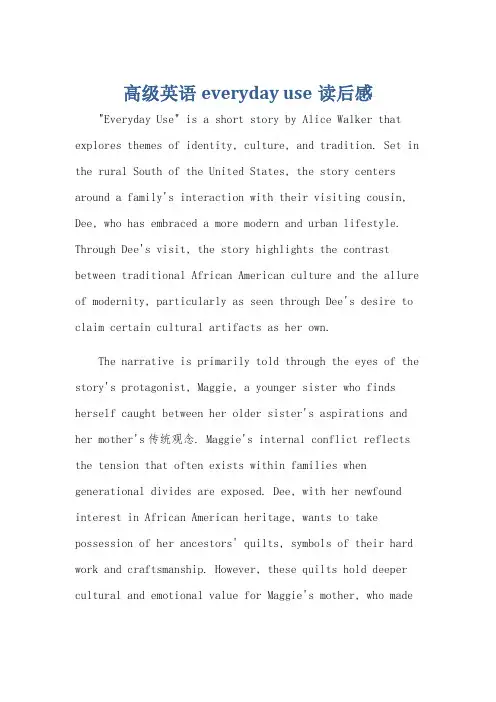
高级英语everyday use读后感"Everyday Use" is a short story by Alice Walker that explores themes of identity, culture, and tradition. Set in the rural South of the United States, the story centers around a family's interaction with their visiting cousin, Dee, who has embraced a more modern and urban lifestyle. Through Dee's visit, the story highlights the contrast between traditional African American culture and the allure of modernity, particularly as seen through Dee's desire to claim certain cultural artifacts as her own.The narrative is primarily told through the eyes of the story's protagonist, Maggie, a younger sister who finds herself caught between her older sister's aspirations and her mother's传统观念. Maggie's internal conflict reflects the tension that often exists within families when generational divides are exposed. Dee, with her newfound interest in African American heritage, wants to take possession of her ancestors' quilts, symbols of their hard work and craftsmanship. However, these quilts hold deeper cultural and emotional value for Maggie's mother, who madethem herself, and for Maggie, who identifies with them as a part of her heritage.Walker's exploration of the theme of identity is particularly poignant in this story. Dee's embrace ofAfrican American culture seems superficial, motivated more by a desire to fit in with a certain social group than by a true understanding and appreciation of the culture's deeper meanings. By contrast, Maggie's connection to her heritageis more authentic, rooted in her personal experiences and memories. This contrast highlights the importance of understanding one's identity not just as a product of external factors but also as a result of internal processes of self-discovery and self-understanding.The story also raises questions about the role of tradition in shaping individual and collective identities. Dee's rejection of her family's traditional way of life and her embrace of a more urban, modern identity reflect the influence of external forces on individual choices. However, Maggie's reluctance to give up the quilts, despite Dee's offers of more "practical" gifts, suggests that traditioncan also serve as a powerful anchor, grounding individuals in their cultural heritage.Walker's use of symbolism in "Everyday Use" is also noteworthy. The quilts, which Dee desires so eagerly, serve as symbols not only of craftsmanship but also of the older generation's wisdom and experience. By refusing to give up the quilts, Maggie's mother and Maggie herself are effectively rejecting Dee's shallow understanding of her heritage and affirming their own deeper connection to it. In conclusion, "Everyday Use" is a profound exploration of identity, culture, and tradition. Through the contrasting narratives of Dee and Maggie, Walker challenges readers to consider the complexity of identity formation and the role of tradition in shaping it. The story encourages us to question our own assumptions aboutidentity and heritage, and to embrace the rich tapestry of our cultural backgrounds with pride and respect.**《日常用品》读后感**《日常用品》是爱丽丝·沃克的一篇短篇小说,探讨了身份、文化和传统等主题。
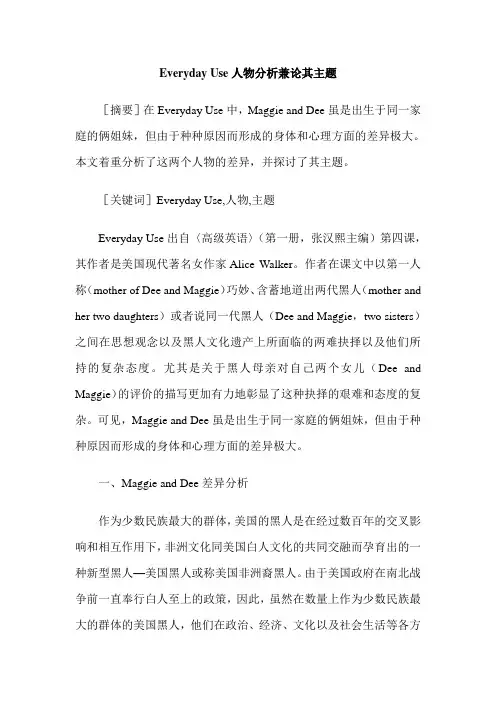
Everyday Use人物分析兼论其主题[摘要]在Everyday Use中,Maggie and Dee虽是出生于同一家庭的俩姐妹,但由于种种原因而形成的身体和心理方面的差异极大。
本文着重分析了这两个人物的差异,并探讨了其主题。
[关键词]Everyday Use,人物,主题Everyday Use出自〈高级英语〉(第一册,张汉熙主编)第四课,其作者是美国现代著名女作家Alice Walker。
作者在课文中以第一人称(mother of Dee and Maggie)巧妙、含蓄地道出两代黑人(mother and her two daughters)或者说同一代黑人(Dee and Maggie,two sisters)之间在思想观念以及黑人文化遗产上所面临的两难抉择以及他们所持的复杂态度。
尤其是关于黑人母亲对自己两个女儿(Dee and Maggie)的评价的描写更加有力地彰显了这种抉择的艰难和态度的复杂。
可见,Maggie and Dee虽是出生于同一家庭的俩姐妹,但由于种种原因而形成的身体和心理方面的差异极大。
一、Maggie and Dee差异分析作为少数民族最大的群体,美国的黑人是在经过数百年的交叉影响和相互作用下,非洲文化同美国白人文化的共同交融而孕育出的一种新型黑人—美国黑人或称美国非洲裔黑人。
由于美国政府在南北战争前一直奉行白人至上的政策,因此,虽然在数量上作为少数民族最大的群体的美国黑人,他们在政治、经济、文化以及社会生活等各方面却一直处于无权和被压迫的境地。
Alice Walke生于1944年,此时的美国在政治上较之从前已经发生了天翻地覆的变化。
比如说,轰轰烈烈的、席卷全国的废奴运动业已结束,发端于20 世纪20年代纽约市黑人聚居区—哈莱姆的“黑人文艺复兴”也方兴未艾。
因此,她所耳闻目睹的美国黑人无论在政治、经济还是文化等方面都有了明显的改观。
事实上,Alice Walke时代的美国黑人正面临着这样一种两难抉择:一方面,他们要不失时机地与白人交流和融合;另一方面,他们又必须想方设法地保全自己的传统和文化。
everydayuse故事总结
《everydayuse》讲述的一个黑人家庭母女两代久别重逢的一天,大女儿Dee有娇好的面容,优美的身姿,伶牙齿,勇敢自信,有自己的风格,还将自己的名字改为Wangero,想要寻找民族文化之根,却以一种局外人的态度来欣赏本来应该属于自己民族文化遗产的东西;小女儿Maggie虽然没有好看的面孔,聪慧的头脑,甚至还有点自卑,但却真正记住了自己的传统文化和那一份亲情,还决定将属于自己的被子让给Dee。
但是在决定将被子给谁时,Mama做出了一件以前从未做过却无比正确的事情:将Maggie一把楼过来,把她拉进卧房里,然后一把从Wangero手中夺过被子放在Maggie的大腿上,因为她最终发觉Maggie才是民族文化和家族传统的真正继承者。
这不禁让我想起了中国文化博大精深,源远流长,但随着时光的变迁以及西方文化的传播,有些传统已渐渐离我们远去。
文化是多样性的,我们应该正确地对待各个民族的文化:既要认同本民族文化,加以传承,又要尊重其他民族文化,相互借鉴,求同存异,而不是一味盲目地追求西方文化,却对自己的文化及传统置之不理。
有人会说:自己民族的文化有些会阻碍社会进步、妨碍人的发展。
毋庸置疑,文化也有好坏之分,那要怎样正确地对待自己的传统文化呢?简而言之,可以归纳为:取其精华,舍其糟,批判继承,古为今用。
只有这样,我们才能从真正意义上理解自己的文化。
故事是通过黑人母亲来讲述的:大女儿迪受过大学教育,具有独立精神和现代意识,美丽自信而时尚;小女儿麦吉一直与母亲住在偏僻的乡下,相貌普通、自卑而胆怯,主要是因为小时候经历的一场火灾在她身上留下了疤痕。
小说围绕着迪从大城市回到乡下与母亲和妹妹之间发生的一场冲突来展开的。
表面上看,母女之间的冲突是由家里的两床被子引起的,但评论家们大多认为‚被子‛象征文化遗产或艺术,麦吉和迪关于‚被子‛用途的冲突象征两种艺术价值观或文化遗产价值观的冲突。
也有评论者认为,小说探讨了母亲和两个女儿对她们的身份(identities) 和家族(ancestry) 的相互冲突的观点。
我们认为,黑人妇女的生存状态一直是沃克写作的焦点,在这篇小说中,作者通过母女之间的冲突来反映黑人微妙的家庭关系、黑人女性的生存状态及精神世界,显示了作者艾丽斯〃沃克对黑人女性的深切关注,并凸显出其对黑人女性精神家园的探索和对黑人文化的认同。
一、作品中的女性人物分析(一) 母亲小说中的母亲代表了一个能干而又谦卑的普通传统黑人劳动妇女形象。
‚在现实生活中,我是一个大块头的女人,有双粗糙得像男人一样的手。
‛‚冬天睡觉时,我穿着法兰绒的睡袍。
白天都穿着工作装。
‛‚我可以像男人一样毫不手软地杀死并拾掇好一头猪。
‛小说没有提到她的丈夫,作者借此是想要强调这位母亲的勇敢、自立,辛勤操劳,独自把两个女儿抚养成人;另一方面,母亲谦卑而又顺从,她不敢直视陌生白人男子,‚谁敢想象我会直视一个陌生白人男子的眼睛? 似乎我跟他们说话时也会随时抬腿溜走,我的头尽可能朝着离他们最远的方向。
‛母亲知道这对她很不利,她明白大女儿迪对她的希望是:‚体重减轻一百磅,皮肤像没烤过的大麦饼那样细腻光滑??‛‚口齿伶俐‛、‚思维敏捷的脱口秀主持人约翰尼〃卡森得费很大的劲才赶得上我。
‛其实,这也是母亲自己内心深处的梦想,但她知道这是永远都不可能实现的。
虽然美国呼唤女性解放、强调男女平等的女权主义运动在20 世纪60 年代- 70 年代兴起了第二次高潮,但就事实而言,黑人妇女并没有被包括在内,美国社会根深蒂固的种族歧视导致白人女权主义者很难将黑人妇女看作是平等的姐妹。
Character Analysis in Alice Walker's Everyday UseMamaMama, the narrator of the story, who is strong, hardworking as well as stern, she has many good qualities of the traditional black women. Unlike her young daughter, Maggie, she has her own outlook on life and values, even though she is a black woman and doesn’t have a good education. In the beginning of the article, we can see she also long for the meeting with her older daughter, because she and Dee sweep the yard so clean and wavy to wait for Dee. She even imagines that one day she and Dee could go for a popular TV show before she sees Dee, it tells us that she expects that Dee could respect and love her like other girls who show to their mothers. In the climax of the essay, Dee wants to rob the family heirloom, the quilts, which she had promised to give Maggie as her dowry. This time, she doesn’t meet the demand of Dee. As a mother, she is fair to her two daughters, even Dee and Maggie is as different as heaven and earth. At last, she even get angry with Dee, she couldn’t understand why Dee is so greedy and peacockish. In conclusion, Mama is a uneducated but practical character, she standing for the traditional black women in that stage.DeeDee is the object of jealousy, awe, and agitation among her family members, while as an individual she searches for personal meaning and a stronger sense of self. She get a good education. She is arrogant and always feels that she should enter into the white world, so she leaves her country and keeps on her pursuit in the big city. Actually, Dee is a tragic character, she is an ambivalent syntheses. On one hand, indeed, she doesn’t integrate into the white society. On the other hand, she has abandoned the old ideology and costumes of the traditional black people. Superficially, she own fashionable clothes and valuable jewelry, it seems that she has got the life what she has been pursuing for a long time. Actually, she couldn’t get the sense of belonging and sense of security in the big city, so she want to rob the quilts to meet her vanity, she just want to show off the quilts to the people in the city and tell them that she is not a black woman who owns nothing. In conclusion, Dee standing for one kind of people in that period that they have abandoned their hometown and origins to pursue a better life in big cities, but they can’t integrate into the white people either.MaggieMaggie, Nervous and maladjusted, she is a figure of purity, uncorrupted by selfishness or complex emotional needs. God is unfair to her, she has an excellent, beautiful sister, but she is ugly, clumsy and diffident. So she lives in her sister’s shadow for a long time. She even never spares efforts to strive for her proper interests. When Dee says that she wants to take the quilts, Maggie doesn’t say “no”. She lives at home and is protected by Mama, remaining virtually untouched by the outside world. She suffers from shyness and lack of education. She is also a tragic character. As a girl, she has ugly scars in her body and doesn’t get a good education, because of this, Dee even doesn’t think Maggie should have the right to inherit the heirloom. In the future,if the Mama passes away, it is a question whether Maggie could manage her life successfully or not. In contrast, Maggie is less sophisticated than her sister and less competent than her mother. In conclusion, Maggie standing for one kind of people in that society who still adhere to the past practices and they will inherit the tradition from generation to generation.。
Everydayuse人物分析《Everyday use》这个短篇小说,主要展现了一个家庭内部因为文化和认同上的差异而引起的冲突。
故事的三个主要角色分别是母亲玛玛、玛玛的大女儿迪·汉、和她的妹妹玛吉,每个角色都有它独特的性格和行为举止。
玛玛是故事中的思考者与旁观者,在这个家庭中起着重要的调和作用,由她所描绘的场景让读者更好地了解了这个家庭的背景和人物角色。
玛玛是一个充满智慧和思辨性的母亲,她很清楚自己居住的社会地位和文化背景,知道自己的夫婿为了保护他们的文化和传统,为了他们的未来而努力工作。
即便是在家庭中,她也是那个对于家中居住的每个人的状况了解最为清晰的人,而在这段时间中包括了她的女儿们的状况。
玛玛试图在女儿之间调解,她支持迪·汉放弃那些保存着家庭的家具,但她的看法并不是一步到位的。
她很清楚玛吉的状况,同时也很明白迪·汉的想法,她尽可能地做到了公正,这让她成为了“Everyday use”中最具代表性的人物之一。
迪·汉是玛玛的长女,她是一个更加自信和内敛的女孩。
她受到高等教育的启示,对于自己的家庭和文化有了更多了解,对于传统和家族宝物有一种更现代的看法。
对于永久保存家族珍贵物品的想法,她有着很自信的看法,“我们需要现代家具,而那些古老家具可以在家庭历史或博物馆展览中保存。
”虽然她的想法是理性的,但是她却忽略了家族的传统和文化价值,缺乏对于历史价值的认同和尊重。
她的看法和态度,使她的母亲和妹妹感到有些不满和失望。
玛吉则是另一个极端的代表,她是一个缺乏自信的人,她的外表大多数时间都表现出一种强烈的无助和依赖感。
她的父亲曾经救过她,在火灾中,她受到了严重的身体伤害,这使她对生活产生了一定的颓废情感,她对于自己家族的文化和传统也不太懂得欣赏和理解。
她认为自己的外表、教育和看法都不符合美国主流的文化价值,但这种伤害感只是加深了她在家庭中的固有形象:总的来说,《Everyday use》中的三个人物代表了文化差异和认同差异所引起的现实问题。
人物分析After I have learnt the Everyday Use, the mother’s image is deeply impressed in my mind. The author is Alice Walker. She is one of the minority writers recognized and appreciated by the majority of people. As a black women writer, her background provides the sources of her work, especially work describing colored people’s life.First of all, I want to analysis her from the family character.She is tje mother of two different quality girls.On the one hand, Dee is the healthy one. She has an appearance which admired by most people. Just as the author says" Dee is lighter than Maggie, with nicer hair and a fuller figure. "Dee is not only excellent in her outlook, but also she has a good brain. And she is good at showing herself to others. But, Maggie is not quite healthy as her sister. Just as the author says in the beginning part of the work. She is shy and lack of confidence. Most of time, Maggie stands behind her mother. On the other hand, Dee has great curiosity about white culture and modern society, but Maggie is the traditional one. Even the two daughters are quite different, mama treats them as equal. She likes them all very sincerely. Before Dee comes back home,mama dreams one day she could appear on the TV show. It looks like mama wants her daughter Dee feels proud of her. "Sometimes I dream a dream in which Dee and I are suddenly brought together on a TV program of this sort. "But it is just a dream, in reality, she introduces herself as “a large, big-boned woman with rough, man-working ha nds.”Maggie who is her little daughter always living with her. For most parents' view, the little child should pay more attention. In the last part of the author's work, when Dee and Maggie are fighting for the quilt. The mama snatches the quilts from Dee and offer her instead some of the machine-stitched ones, which Dee does not want. Maybe it is the only and first time, Maggie wins. But it doesn't mean she dislike Dee, she just is puzzled that why Dee is so curiosity about the quilts. In mama's view, Dee is reasonable. From this I know, mama's way of love for the two daughters is different, but she loves them deeply. She wants them all have a happy family.The mother is a traditional black woman. She is shy and not dare to face the unknown white man."I never had an education myself. After second grade the schoolwas closed down. Don't ask my why: in 1927 colored asked fewer questions than they do now."Mama never has an education herself. In her words, she indicates that the black people's right has been seriously invaded. " I used to love to milk till I was hooked in the side in '49. Cows are soothing and slow and don't bother you, unless you try to milk them the wrong way."Mama's rib is been hurt very harm. But she thinks it is not the cow's fault, it's because her way of milking. She is quite kind and reasonable. "When she comes I will meet—but there they are!" Mama is so surprised and delighted to see her daughter Dee comes back home. After Dee is at home, she told mama, "Not Dee,Wangero Leewani Ka Kemanjo! "At first, I think the mama must be angry for the girl changed her name by herself. But to my astonishment, mama trys her best to call the new name. She just tells to her daughter, "Why shouldn't I? " She asked."If that's what you want us to call you,we'll call you."After I read this, I know she is a brilliant mother. She could accept Dee to use her new name Wangero, which has no “bad” history. As we all know that Dee is the symbol of the new culture. All these actions show us that she is a little bit like the white culture, or somehow, she is curious about it. From all this, we can get that the Mama in the fiction is a black woman who is protecting the Black Culture and the true meaning of black art. In Maggie and Mama’s opinion, the things which they are using everyday is the black art, and the true meaning of black art is not to show, but to use everyday use everyday.。
On the Character of Dee in Everyday Use Alice Walker’s Everyday Use was written in her early time. The short story was written during the heyday of the Black Power Movement. When I learned Everyday Use, my teacher talked much about how to treat traditional culture. In Alice Walker’s novel, mother and Maggie represent the traditional culture of black, while Dee highly praises the culture of white. She didn’t know about the meaning of the traditional culture of black. Dee and Maggie have extremely contrastive characters: Dee being successful, beautiful but arrogant type of woman, Maggie being simple-minded, disfigured and slow. I will analyze the character of Dee as follows:I Being selfishWhen the house burned, “I see Dee standing off under the sweet gum tree she used to dig gum out of; a look of concentration on her face as she watched the last dingy gray board of the house fall in toward the red-hot brick chimney. Why don’t you do a dance around the ashes? I’d wanted to ask her. She had hated the house that much.” Dee was selfish and she hated the old house. She didn’t take her mother’s feeling in consideration. Besides, Dee asked for dasher, churn and quilts. Dee refused to take another two quilts.II Being independent and determinedDee was independent and determined. “Dee, though. She would always look anyone in the eye. Hesitation was not part of her nature.”Her mother collected money for Dee and Dee went to the college. Since she was very young, she had gotten rid of the protection of her mother. Dee had her own style, no matter which to choose or how to do, she had never asked for help.III Being arrogantDee didn’t like her mother and her house, so she never brought her friends back home. When she came back home, She changed her name “Dee”into “Wangero Leewanika Kemanjo”, a traditional African name. Besides, she changed her hair and dressing style. Dee took photos for the house, the cow and Maggie to show the old fashion off to her friends. But now it was different, Dee not only took photos, but also took her boyfriend back home. Compared with her former attitude towards everyday use, Dee showed tremendous cherish. She walked around the house to seek anything that had long history.In the past, the mother wanted to give the quilts to her elder daughter Dee. But Dee rejected them as too old-fashioned and out of style. Therefore the mother promised the quilts to her younger daughter Maggie. Now Dee asks her mother for the quilts and some more pieces of their family heritage because she now regards them as part of her cultural heritage, which she intends to hang on the wall. She wanted to show that she knew about African culture. So she was arrogant.In the end, against the expectation of Dee, the mother refused her wish and gave the quilts to Maggie, who would have agreed to give the quilts to her sister. Dee left without a piece of her family heritage, with her mother being satisfied with their simple southern life and with her sister Maggie, who would put the quilts to everyday use.From this novel, we should learn to have a right attitude to our culture and know the real meaning.。